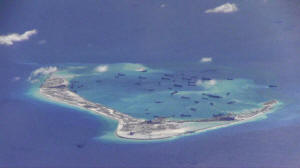|
Exclusive: China finishing South China
Sea buildings that could house missiles - U.S. officials
 Send a link to a friend
Send a link to a friend
 [February 22, 2017]
By Idrees Ali [February 22, 2017]
By Idrees Ali
WASHINGTON (Reuters) - China, in an early
test of U.S. President Donald Trump, has nearly finished building almost
two dozen structures on artificial islands in the South China Sea that
appear designed to house long-range surface-to-air missiles, two U.S.
officials told Reuters.
The development is likely to raise questions about whether and how the
United States will respond, given its vows to take a tough line on China
in the South China Sea.
China claims almost all the waters, which carry a third of the world's
maritime traffic. Brunei, Malaysia, the Philippines, Taiwan and Vietnam
also have claims. Trump's administration has called China's island
building in the South China Sea illegal.
Building the concrete structures with retractable roofs on Subi,
Mischief and Fiery Cross reefs, part of the Spratly Islands chain where
China already has built military-length airstrips, could be considered a
military escalation, the U.S. officials said in recent days, speaking on
condition of anonymity.
"It is not like the Chinese to build anything in the South China Sea
just to build it, and these structures resemble others that house SAM
batteries, so the logical conclusion is that's what they are for," said
a U.S. intelligence official, referring to surface-to-air missiles.
Another official said the structures appeared to be 20 meters (66 feet)
long and 10 meters (33 feet) high.

A Pentagon spokesman said the United States remained committed to
"non-militarization in the South China Sea" and urged all claimants to
take actions consistent with international law.
In Beijing, Chinese Foreign Ministry spokesman Geng Shuang said on
Wednesday he was aware of the report, though did not say if China was
planning on placing missiles on the reefs.
"China carrying out normal construction activities on its own territory,
including deploying necessary and appropriate territorial defense
facilities, is a normal right under international law for sovereign
nations," he told reporters.
In his Senate confirmation hearing last month, U.S. Secretary of State
Rex Tillerson raised China's ire when he said Beijing should be denied
access to the islands it is building in the South China Sea.
Tillerson subsequently softened his language, and Trump further reduced
tensions by pledging to honor the long-standing U.S. "one China" policy
in a Feb. 10 telephone call with Chinese President Xi Jinping.
LONGER RANGE
Greg Poling, a South China Sea expert at the Center for Strategic and
International Studies in Washington, said in a December report that
China apparently had installed weapons, including anti-aircraft and
anti-missile systems, on all seven of the islands it has built in the
South China Sea.
The officials said the new structures were likely to house
surface-to-air missiles that would expand China's air defense umbrella
over the islands. They did not give a time line on when they believed
China would deploy missiles on the islands.
"It certainly raises the tension," Poling said. "The Chinese have gotten
good at these steady increases in their capabilities."
[to top of second column] |

Chinese dredging vessels are purportedly seen in the waters around
Mischief Reef in the disputed Spratly Islands in the South China Sea
in this still image from video taken by a P-8A Poseidon surveillance
aircraft provided by the United States Navy May 21, 2015. U.S.
Navy/Handout via Reuters/File Photo

On Tuesday, the Philippines said Southeast Asian countries saw
China's installation of weapons in the South China Sea as "very
unsettling" and have urged dialogue to stop an escalation of "recent
developments."
Philippine Foreign Secretary Perfecto Yasay did not say what
provoked the concern but said the 10-member Association of South
East Asian Nations, or ASEAN, hoped China and the United States
would ensure peace and stability.
POLITICAL TEST
The U.S. intelligence official said the structures did not pose a
significant military threat to U.S. forces in the region, given
their visibility and vulnerability.
Building them appeared to be more of a political test of how the
Trump administration would respond, he said.
"The logical response would also be political – something that
should not lead to military escalation in a vital strategic area,"
the official said.
Chas Freeman, a China expert and former assistant secretary of
defense, said he was inclined to view such installations as serving
a military purpose - bolstering China's claims against those of
other nations - rather than a political signal to the United States.
"There is a tendency here in Washington to imagine that it's all
about us, but we are not a claimant in the South China Sea," Freeman
said. "We are not going to challenge China's possession of any of
these land features in my judgment. If that's going to happen, it's
going to be done by the Vietnamese, or ... the Filipinos ... or the
Malaysians, who are the three counter-claimants of note."
He said it was an "unfortunate, but not (an) unpredictable
development."
Tillerson told the Senate Foreign Relations Committee last month
that China's building of islands and putting military assets on them
was "akin to Russia's taking Crimea" from Ukraine.

In his written responses to follow-up questions, he softened his
language, saying that in the event of an unspecified "contingency,"
the United States and its allies "must be capable of limiting
China's access to and use of" those islands to pose a threat.
(Reporting by Idrees Ali; Additional reporting by Arshad Mohammed
Arshad, David Brunnstrom and John Walcott, and Ben Blanchard in
Beijing; Editing by John Walcott, Peter Cooney and Nick Macfie)
[© 2017 Thomson Reuters. All rights
reserved.]
Copyright 2017 Reuters. All rights reserved. This material may not be published,
broadcast, rewritten or redistributed. |